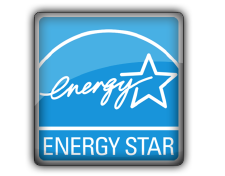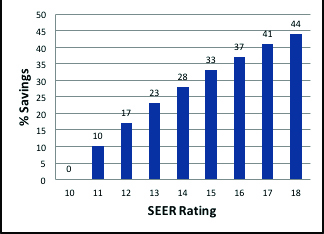Understanding Energy Efficiency Measures for Heating and Cooling Systems
We see the terms “Btu,” “SEER,” “HSPF” and “AFUE” when describing the efficiency of heating and cooling systems. Contractors and vendors also describe the “tonnage” of the heating and cooling units. Is this describing the weight of the unit? If you are looking for a new heater, air conditioner or heat pump, be familiar with these acronyms. This Fact Sheet discusses the terms along with some other pertinent heating, ventilation and air conditioning (HVAC) topics.
Btu: “British Thermal Unit”
The amount of heating and cooling an air conditioner or heater is capable of providing is listed in “Btu’s” (British Thermal Units). This old descriptive scientific unit dates back to the mid-1800s and is still used in North America. Essentially, a Btu is the amount of heat energy required to raise the temperature of one pound of water (about a pint) one degree Fahrenheit in one hour. This is also about the amount of energy given off by completely burning a wooden kitchen match. So, one Btu is not very much energy and thousands of Btu’s are used to describe heating and cooling equipment.
Why use a heating unit to describe an air conditioner? Because an air conditioner is really just moving heat – not producing “cold.” There actually is no such thing as a unit of cold – just units of heat moving out of a space (from the inside of your house on a hot day).
Tons of Cooling/Heating
Size or Capacity of Air Conditioning, Heating or Refrigeration Equipment
This is another old British scientific unit. It comes from the amount of heat required to melt one ton of ice in 24 hours, starting at 32 F. More importantly, one ton of cooling (or heating) is equivalent to moving 12,000 Btu’s per hour. Therefore, a “three ton” AC unit can move 36,000 Btu’s of heat per hour out of a space. Typical home air conditioning units are 3 tons to 7 tons in cooling capacity. This “ton” number is used to describe how much cooling or heating the unit can provide. Obviously the bigger the space, the more tons the unit has to be to move the heat. A window AC unit for a small bedroom might only be half a ton (6,000 Btu’s per hour) in size. The better insulated a building space is, the smaller (fewer tons) the AC or heater needs to be. The appliance “tonnage” is directly related to how much electrical power the unit consumes as well.
Correct Unit Sizing
The specifics of how a contractor should determine the correct size, or capacity, of a heater or AC unit will not be discussed here. However, itt should be based on some type of calculation of the heat moved in a particular building. Usually this is done with very specialized software that needs details of the building, usage and local climate. Guessing is not an acceptable method of sizing HVAC equipment. Undersized equipment will not meet comfort standards and the problems are obvious. Therefore, when people estimate HVAC equipment size they tend to overestimate. This also has problems. Oversized equipment runs repeatedly for very short periods. This does not allow humidity to be removed from the home, is hard on equipment, is less efficient and the larger equipment has higher initial costs. Once the HVAC equipment is installed at the house, it is very expensive to fix a sizing mistake.
ENERGY STAR®
This logo can be seen on all sorts of things from computers to entire homes to air conditioners (Figure 1). The mark is part of an energy efficiency rating program developed by the U.S. Environmental Protection Agency and the U.S. Department of Energy. While its main aim is the reduction of greenhouse gases by increased energy efficiency, it has become synonymous with energy efficiency standards for more than 70 product categories. Sometimes utilities or manufacturers offer rebates or other incentives for ENERGY STAR® certified products.

Figure 1. ENERGY STAR® Logo.
SEER: Seasonal Energy Efficiency Ratio
This is the total cooling capacity of an air conditioner or heat pump in Btus during its normal annual usage, divided by the total electric input in watt-hours during the same time period. The higher the SEER number, the more efficiently the unit is at converting electricity into cooling for the home. This is very similar to miles per gallon in cars. In other words, a higher SEER air conditioner will cost less to operate than a similar size unit with a lower SEER. A 13 SEER AC unit is about 23 percent more efficient than a 10 SEER unit. Another way to think of this is that the 13 SEER unit will save about 23 percent of the cost to run the 10 SEER unit during a year (Figure 2). Some efficient equipment can have SEER ratings of more than 20.
Figure 2. Energy cost savings due to higher SEER rating versus a SEER 10 unit.
HVAC units in the U.S. make up a significant amount of the national energy consumption.
For this reason, the Department of Energy keeps raising the minimum SEER number allowable
for new air conditioners and heat pumps sold in the U.S. At present, the minimum standard
SEER for newly manufactured air conditioning and heat pump units (other than window
units) is 13 SEER. As a buyer, however, even higher SEER units are available, but
will initially cost more. High efficiency ENERGY STAR® units must have a SEER of at
least 14. One has to weigh the increase in initial cost versus the yearly savings
to determine if it is desirable to spend more for a higher SEER unit. Window AC units
are exempt from these regulations and their efficiency tends to be around 10 SEER
when new.
It should be mentioned that a unit’s actual SEER rating will decline over time as coils get dirty, motors and compressors age, and the refrigerant degrades. The SEER rating also declines as the outside temperature rises. If the unit is installed incorrectly or the ductwork is leaky and not well made, the actual overall SEER rating can be much lower as well.
HSPF: Heating Seasonal Performance Factor
This measure is for heat pumps in the heating mode. This is the total heating output of the heat pump during its normal annual usage divided by the total electric input in watt-hours during the same time period. This rating is similar to the SEER rating, but is for heating and is used only with heat pumps. Like the SEER rating, the higher the HSPF, the more efficient the unit is at heating. And similarly, the higher the HSPF, the less the unit costs to heat a space during one year (Figure 3).
Figure 3. Energy cost savings due to higher HSPF rating versus an HSPF 7.7 unit.
As of January 23, 2006 the government established minimum standards for newly manufactured
heat pumps at 7.7 HSPF. Split system heat pumps that are considered high-efficiency
have at least an HSPF of 8.2 (some units currently go as high as 9.35). Ground source
heat pumps (“geothermal”) tend to have high HSPF’s because the heat source (ground
temperature) is very stable and predictable, therefore the equipment can be designed
very specifically. The consumer pays more for equipment with higher HSPF ratings and,
like the AC units, it becomes a decision of initial cost versus yearly savings for
new equipment.
AFUE: Annual Fuel Efficiency Ratio
This measure is for oil or gas (not electric) fired heaters and boilers. Similar to SEER and HSPF, this compares the heater’s annual heat (energy) output to its annual energy input in Btu’s. The calculation is a bit complicated and includes expected pilot flame losses and heater use during a typical year at an “average” location in the U.S. The minimum allowed AFUE rating for a non-condensing (typical home heater) fossil-fueled, warm-air furnace is 78 percent; the minimum rating for a fossil-fueled boiler is 80 percent; and the minimum rating for a gas-fueled steam boiler is 75 percent. However, there are some systems capable of very high AFUE’s of around 97 percent. Again, these systems will be more expensive and the consumer must weigh the lower fuel use against the higher initial cost (see Table 1).
EER and COP
These two measures are typically used by engineers for large systems and may not be encountered very often by consumers, but are included here for information.
EER (Energy-Efficiency Ratio)
An air conditioner’s EER, or Energy-Efficiency Ratio, is the ratio of the cooling output in Btu’s divided by the unit’s power consumption in Watts at a specific temperature (usually 95 degrees Fahrenheit). The higher the EER, the more efficient the model. ENERGY STAR’s® minimum EER requirements for a room air conditioner vary, depending upon capacity, enclosure type and whether or not the model has louvered sides. The SEER rating is probably a better indicator of general efficiency for residential units than EER because it looks at the unit’s operation through variety of conditions and time.
Coefficient of Performance
COP, coefficient of performance, is the measurement of how efficiently a heating or cooling system does its job. As with all the measures described here, a higher COP is more efficient and desirable than a lower one.
A Final Note
Selecting a new heating or cooling unit is a tradeoff between several factors. Initial cost, energy savings, type of fuel, etc. A very important consideration is the quality of system installation including the duct work for air distribution. A 14 SEER system can be brought down to an actual 5 SEER if not installed correctly. Duct work should be insulated and sealed.
Finally, HVAC units are like any other complicated machinery, they need periodic maintenance. The filters need replacing, the coils need to be cleaned on occasion, duct work inspected and thermostat checked. Like a car, the owner must protect the investment through maintenance and periodic inspection.
R. Scott Frazier, PhD, PE, CEM
Oklahoma State Energy Specialist


